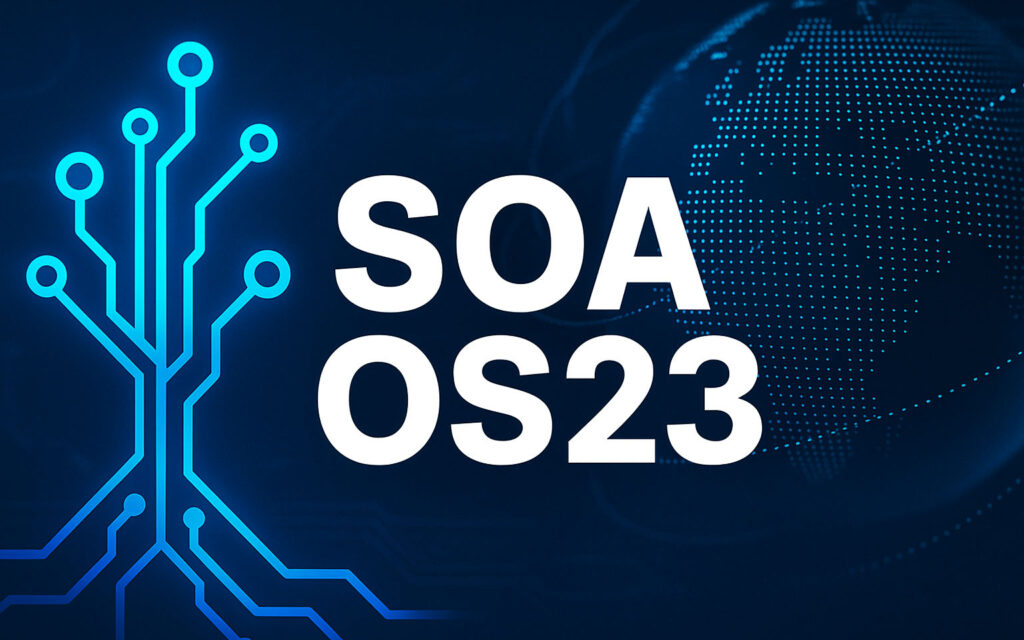In today’s digital-first world, integration is no longer an option but a necessity. Businesses rely on seamless data exchange, connected services, and scalable systems to remain competitive. This is where SOA OS23 comes in as a true game-changer. Designed to address the complexities of modern IT environments, SOA OS23 blends the core principles of Service-Oriented Architecture with next-generation technologies, creating a smarter, more reliable, and future-ready framework. Whether you are a CIO looking to streamline operations, a developer seeking efficiency, or a strategist building for the future, understanding SOA OS23 is the first step toward unlocking efficiency, agility, and innovation.
What Is SOA OS23?
SOA OS23 refers to the latest evolution of Service-Oriented Architecture, one that is designed for the challenges of the 21st century. Traditional SOA has existed for decades, enabling different software components to interact seamlessly through defined services. However, OS23 refines this concept by aligning it with cloud computing, microservices, regulatory frameworks, and automation powered by artificial intelligence. At its core, SOA OS23 is not just a tool but a framework for digital transformation. It redefines how businesses design, deploy, and manage services, ensuring that systems remain interoperable, adaptable, and future-proof.
The Evolution of SOA to OS23
To appreciate the impact of SOA OS23, it is important to understand its journey. Traditional SOA in the early 2000s focused mainly on standardizing communication between applications. While effective at the time, it often lacked the flexibility that modern businesses demand. As enterprises began shifting to the cloud in the 2010s, scalability and service discovery became pressing issues.
The rise of microservices further highlighted the need for lightweight, independent, and modular services instead of large centralized systems. SOA OS23 is the natural next step in this journey, combining the structure of SOA with the agility of microservices. It emphasizes security, compliance, automation, and orchestration across distributed systems, making it the foundation for today’s digital ecosystems.
Why SOA OS23 Matters Today
In the digital age, customer expectations are higher than ever. A single system failure can cost millions in lost revenue and harm an organization’s reputation. SOA OS23 addresses these risks by ensuring greater agility, stronger compliance, faster integration, and readiness for future technologies. Organizations can adapt quickly to new business models, meet complex regulatory requirements such as GDPR or HIPAA, and integrate legacy systems with modern platforms in a cost-effective manner. Most importantly, SOA OS23 positions enterprises to grow alongside emerging technologies like blockchain, AI, and edge computing.
Key Features of SOA OS23
One of the defining features of SOA OS23 is its microservices-friendly design. It embraces the flexibility of microservices without abandoning the foundational strengths of SOA, allowing for modular service design and scalable growth. Another critical feature is its cloud-native compatibility. Whether an enterprise relies on AWS, Azure, or private cloud infrastructures, SOA OS23 ensures seamless deployment across hybrid and multi-cloud environments while maintaining consistent governance. Security and compliance are also at the heart of this architecture, with enhanced encryption, access controls, and built-in compliance templates designed for global standards.
Additionally, SOA OS23 automates service discovery, significantly reducing integration time and providing developers with greater transparency. Its performance optimization features, supported by monitoring and analytics, further ensure that services run at peak efficiency, allowing organizations to maintain operational stability while preparing for growth.
Real-World Applications of SOA OS23

The applications of SOA OS23 extend across multiple industries. In healthcare, hospitals and clinics use it to securely integrate patient records, insurance data, and telehealth applications, leading to faster decision-making and better care. In finance, banks and fintech firms deploy it to connect core banking systems with mobile applications, fraud detection platforms, and regulatory compliance systems, ensuring both security and innovation.
Retailers leverage SOA OS23 to manage real-time inventory, personalize customer experiences, and streamline supply chains, while government institutions employ it to connect citizen services, improve transparency, and comply with strict regulatory frameworks. Each example shows how SOA OS23 creates meaningful impact in industries that depend heavily on integration and compliance.
Benefits of Implementing SOA OS23
Enterprises adopting SOA OS23 enjoy numerous benefits that go beyond technical improvements. By simplifying integration processes, businesses save costs and reduce IT overheads. Operational efficiency improves as services become reusable and adaptable, enhancing the return on investment. Organizations are also able to foster innovation by experimenting with AI, IoT, and blockchain while relying on SOA OS23 as a stable integration backbone.
Customers benefit too, as the speed, reliability, and personalization of digital services increase satisfaction and loyalty. Most importantly, SOA OS23 ensures sustainable scalability, allowing businesses to grow steadily while maintaining system stability and security.
Challenges in Adopting SOA OS23
Despite its advantages, adopting SOA OS23 comes with challenges. Organizations often face skill gaps, requiring staff to be retrained to understand new frameworks. Legacy systems present another hurdle, as integrating outdated technologies can be complex and time-consuming. Cultural resistance also plays a role; shifting from traditional IT practices to service-oriented thinking often meets internal pushback.
Finally, the initial investment in deployment and training may seem high, although the long-term savings and efficiencies generally outweigh the costs. Recognizing and addressing these challenges early is crucial for smooth implementation.
Best Practices for Implementation
Successful adoption of SOA OS23 depends on strategic planning. Enterprises should begin with smaller pilot projects before attempting a full-scale rollout, ensuring that early lessons inform larger initiatives. Training is critical, as equipping teams with the right skills leads to better system optimization. Governance must also be prioritized, with clear policies in place to maintain consistency and compliance across all services.
Automation tools for service discovery, monitoring, and security should be leveraged to minimize human error and maximize efficiency. Most importantly, engaging stakeholders across departments ensures that everyone is aligned, making adoption smoother and more effective.
SOA OS23 vs. Traditional SOA
When comparing SOA OS23 to traditional SOA, the differences are clear. Traditional SOA offered limited scalability, while OS23 enables highly scalable systems through its microservices-driven architecture. Compliance in older models required manual oversight, whereas SOA OS23 integrates compliance frameworks directly into the system. While cloud integration in traditional SOA was basic, OS23 is inherently cloud-native, supporting hybrid and multi-cloud operations. Service discovery, once a manual and time-consuming process, is now automated, saving significant time and resources. Security, which was often reactive in older SOA systems, has become proactive and layered in OS23, protecting organizations against evolving threats. These advancements show why SOA OS23 is not just an upgrade but a complete evolution.
The Future of SOA OS23
The future of SOA OS23 looks promising as enterprises increasingly rely on digital ecosystems. With the rapid adoption of artificial intelligence, IoT, and edge computing, the demand for flexible, secure, and scalable integration frameworks will only grow. Experts predict that by 2030, a significant majority of enterprises will rely on architectures like SOA OS23 to manage digital transformation effectively. Its ability to support new technologies while maintaining compliance and security makes it the backbone of tomorrow’s digital enterprises.
Conclusion
SOA OS23 is more than a technological update—it is a transformative approach to integration and compliance in the digital era. By merging the proven strengths of SOA with modern innovations like microservices, automation, and cloud-native design, it provides organizations with the agility, reliability, and security they need to succeed. While challenges in adoption exist, with the right planning and stakeholder engagement, SOA OS23 becomes a powerful asset for achieving operational excellence and delivering customer-focused experiences. For enterprises ready to modernize systems, scale operations, and embrace innovation, SOA OS23 stands out as the key to unlocking long-term growth and digital success.
Frequently Asked Questions (FAQs)
1. What is SOA OS23?
SOA OS23 is the latest version of Service-Oriented Architecture designed for modern business needs. It combines traditional SOA with microservices, cloud, and automation to make systems more flexible and secure.
2. Why is SOA OS23 important for businesses?
It helps businesses connect different systems, follow compliance rules, and scale faster. By using SOA OS23, companies can improve customer experience and prepare for future technologies.
3. How does SOA OS23 improve security?
SOA OS23 has strong security features like encryption, access control, and compliance templates. These tools protect sensitive data and help organizations meet global regulations.
4. Can SOA OS23 work with older systems?
Yes, one of its strengths is integration with legacy systems. It allows older platforms to connect with modern applications, reducing the need for complete system replacements.
5. What industries use SOA OS23 the most?
SOA OS23 is used in healthcare, finance, retail, and government. These industries rely on it to manage sensitive data, improve services, and meet strict compliance standards.
For More Information Visit Creative News


